1998 BUICK PARK AVENUE wheel
[x] Cancel search: wheelPage 21 of 426
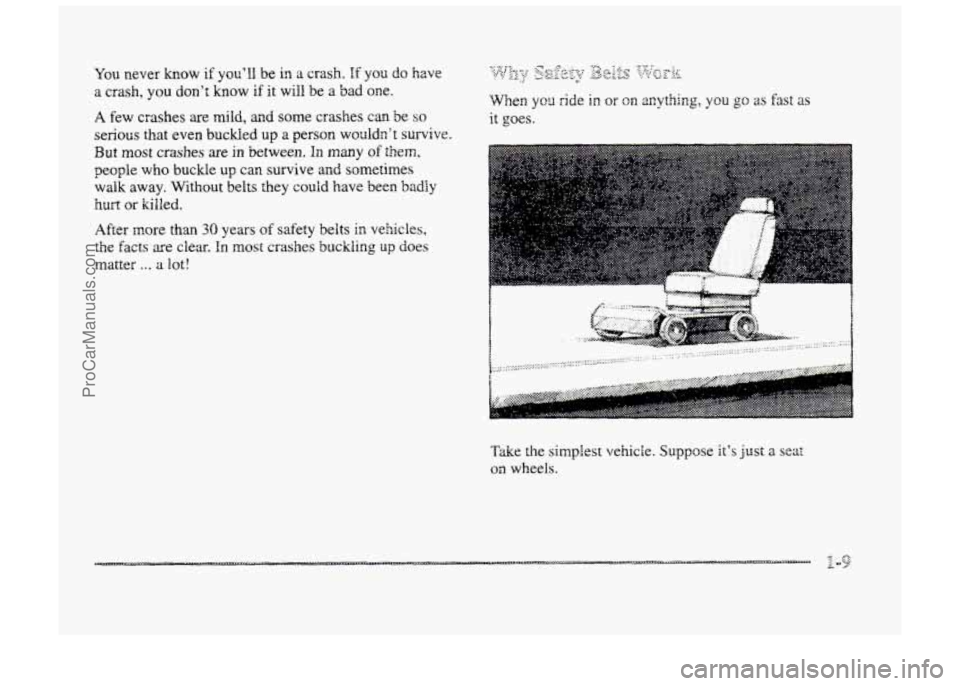
You never know if you'll be in a crash. If yo3 do have
a crash, you don't know if it will be a bad oDe.
A few crashes are mild, and some crashes can be so
serious that even buckled up a person wouldn't survive.
But most crashes are in between. In many of them,
people who buckle up can survive and sometimes
walk away. Without belts they could have been badly
hurt or killed.
After more than 30 years of safety belts in vehicles,
the facts are clear. In most crashes buckling up does
matter ... a lot!
..... .............................. :.:::::;:.:.::::.:.:.:-:: .................... ................................................ _..: ..... .*.....-
Fake the simplest vehicle. Suppose It's just a seat
on wheels.
ProCarManuals.com
Page 35 of 426
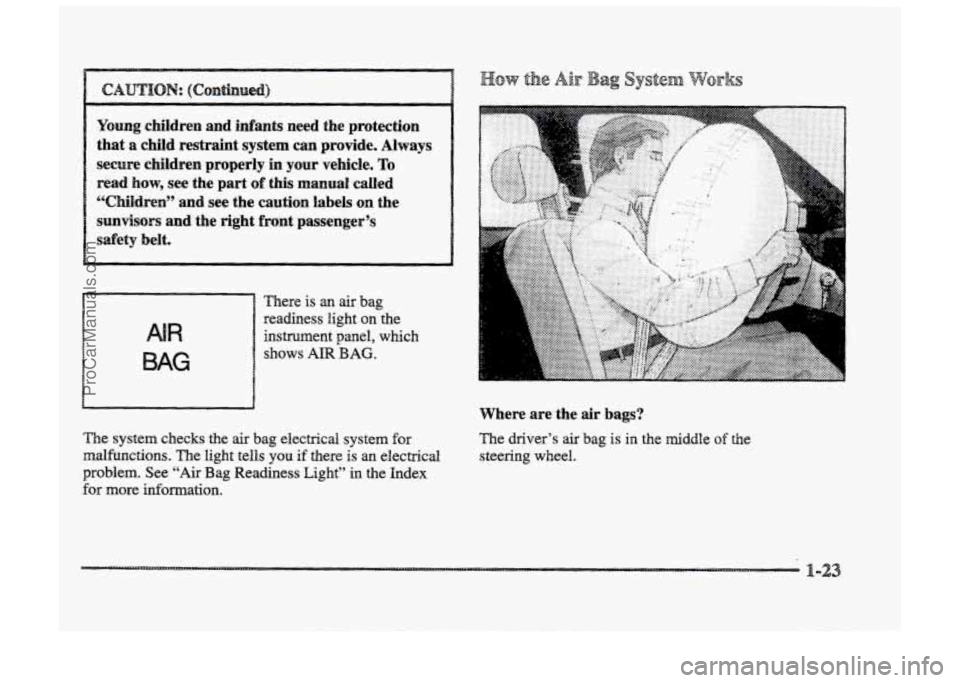
CAmHoN: (CQdIIUd)
Young children and infants need the protection that
a child restraint system can provide. Always
secure children properly in your vehicle.
To
read how, see the part of this manual called
“Children”
and see the caution labels on the
smvisoss and the right front passenger’s
safety belt.
There is an air bag
readiness light
on the
instrument panel, which
BAG
shows AIR BAG.
The system checks the air bag electrical system for
malfunctions. The light
tells YOU if there is an electrical
problem. See
“Air Bag Readiness Light” in the Index
for more information.
..
... ... .; ........
Where are the air bags?
The driver’s air bag is in the middle of the
steering wheel.
ProCarManuals.com
Page 36 of 426
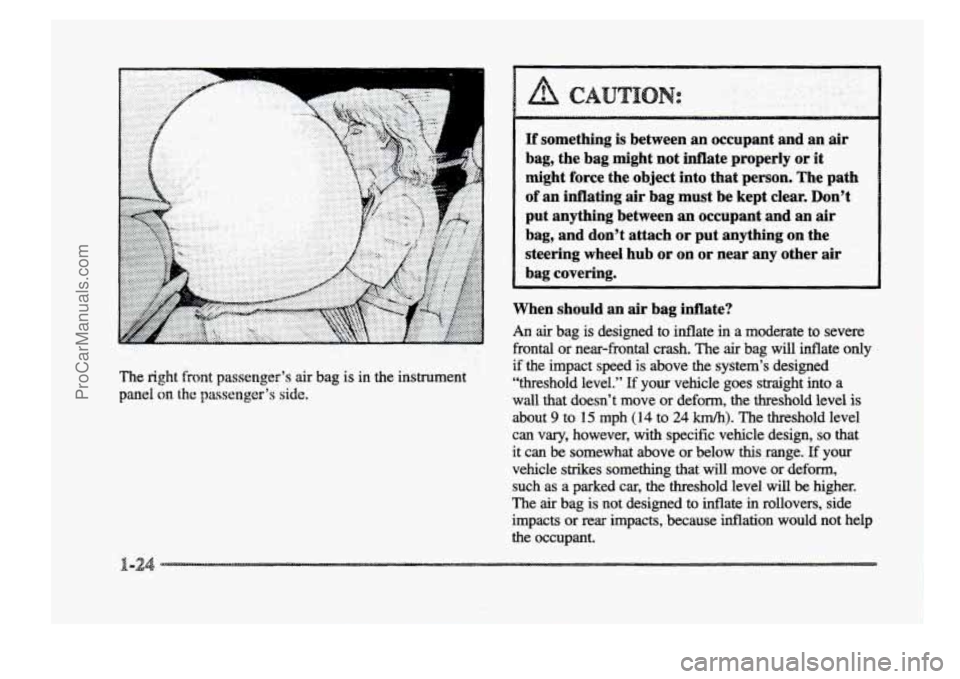
. ..
’ ”I
If something is between an occupant and an air
bag, the bag might not inflate properly or it
might force the object into that person. The path
of an inflating air bag must be kept clear. Don’t
put anything between
an occupant and an air
bag, and don’t attach or put anything on the
steering wheel hub
or on or near any other air
bag ,covering.
The right front passenger’s air bag is in the instrument
panel
an the passenger’s side.
When should an air bag inflate?
An air bag is designed to inflate in a moderate to severe
frontal or near-fiontal crash. The air bag will inflate only
if the impact speed is above the system’s designed
“threshold level.”
If your vehicle goes straight into a
wall that doesn’t move or deform, the threshold level is
about
9 to 15 mph (14 to 24 km/h). The threshold level
can vary, however,
with specific vehicle design, so that
it can
be somewhat above or below this range. If your
vehicle strikes something that
will move or deform,
such
as a parked car, the threshold level will be higher.
The
air bag is not designed to inflate in rollovers, side
impacts or rear impacts, because inflation would not help
the occupant.
ProCarManuals.com
Page 37 of 426
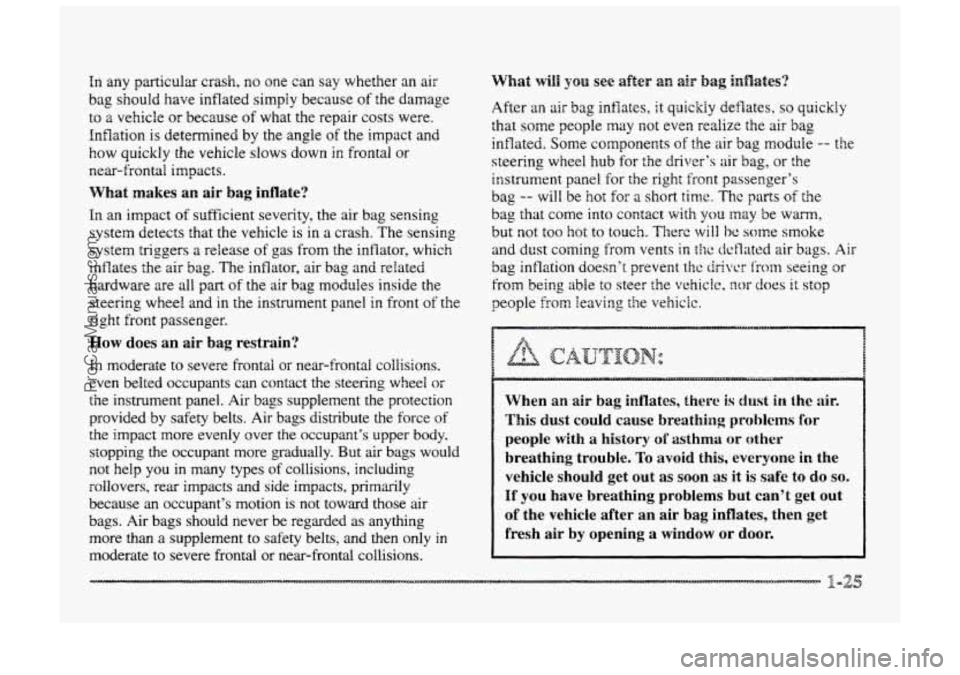
In any particular crash, no one can say whether an air
bag
should have inflated simply because ofthe damage
to
a vehicle or because of what the repair costs were.
Inflation
is determined by the angle of the impact and
how quickly the vehicle slows down
in frontal or
near-frontal impacts.
What makes an air bag inflate?
In an impact of sufficient severity, the air bag sensing
system detects that the vehicle is in a crash. The sensing
system triggers
a release of gas from the inflator, which
inflates the
air bag. The inflator, air bag and related
hardware are
all part of the air bag modules inside the
steering wheel and in the instrument panel in front of the
right front passenger.
How does an air bag restrain?
In moderate to severe frontal or near-frontal collisions,
even belted occupants can contact
the steering wheel or
the instrument panel. Air bags supplement the protection
provided by safety belts. Air bags distribute the force of
the impact more evenly over the occupant’s upper
body.
stopping the occupant more gradually. But air bags would
not help you in many types of collisions, including
rollovers, rear impacts and side impacts, primarily
because an occupant’s motion is not toward those air
bags. Air bags should never be regarded
as anything
more than
a supplement to safety belts, and then only in
moderate
to severe frontal or near-frontal collisions.
What will YQU see after an air bag inflates?
After an air bag inflates, it quickly deflates, so quickly
that
some people may not even realize the air bag
inflated. Some components
of the air bag module -- the
steering wheel hub
for the driver’s air bag, or the
instmrnent panel for the right front passenger’s
bag
-- will be hot for a short time. $he parts of the
bag that corne into contact
with you rnrty be warm,
but not too hot to touch. Therc will bc some smoke
and dust corning
from vents in tlrc rtcBlated air bags. Air
bag inflation doesn’t prevent the ch-iver li.om seeing or
from being able
to steer the vehick. IICX does it stop
people from leaving the vehicic.
When an air bag inflates, there is dust. in the ais.
This dust could cause breathing problerns for
people with a history of asthma or other
breathing trouble. ab avoid this, everyone in the
vehicle should get
out as soon as it is safe to do so.
If you have breathing problems but can’t get out
of the vehicle after an air bag inflates, then get
fresh air by opening a window or door.
ProCarManuals.com
Page 87 of 426

I
LOCK @I: This is the only position from which
YOU can remove the key. This position locks YOU
igition, steering wheel and transaxle. It’s a
theft-deterrent feature.
OFF (C): This position lets YOU turn ofif the engine but
still turn the steering wheel. It doesn’t lock the steering
wrlhee1 like LOCK and it doesn’t send my electrical
power to
the accessories. The instrument panel cluster
will remain powered in OFF to illarminate the gear sWt
indicator. The cluster will also activate the parking brake
fight when the parking brake is set. Use OW if you must
have your vehicle in motion while the engine is
not mnanaing.
RUN (D): This is the position that the switch returns to
after you start YSUP engine and release the switch. This
is &e p~sisi~n for driving. Even when the engine is not
running, you can use RUN to operate your electrical
power accessories anad t~ display some instrument panel
START (E): This position starts your engine. When the
engine
starts, release the key. The ignition switch will
return to RUN for ~a~rrrnal driving.
wdng
lights.
Retained Acces§ory Power
After you turn the ignition off md even remove the key,
you
will still have electrical power to such accessories
as the radio, astroroof ad power windows for up to
10 minutes. Power is shut off if you open a door.
2-21
ProCarManuals.com
Page 90 of 426
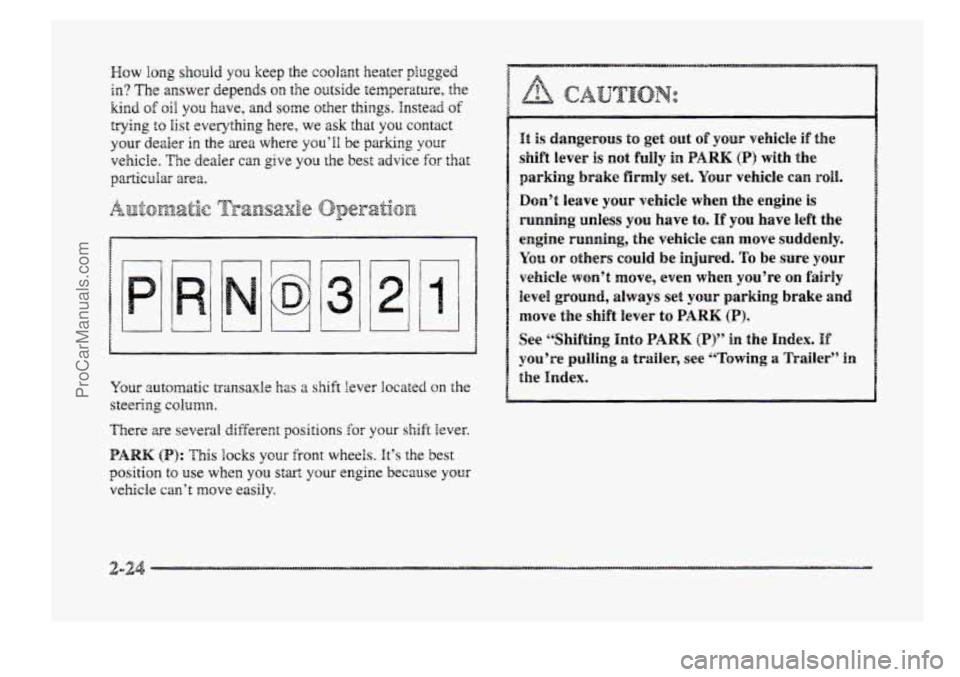
Wow long shodd YOU keep the coolant heater plugged
in? The answer depends on the outside temperature, the
kind of oil you have, and some other things. Instead of
trying t~ list everything here, we ask that you contact
your
dealer in the area where you’ll be parking pur
vehicle. The dealer cm give you the best advice for that
particdar area.
Y0mr automatic transaxle has a shift lever located on the
steering column.
There we several different positions for your shift lever.
PARK (PI: This Bocks your front wheels. It’s the best
position t~ we when YOU start your engine because pl~r
vehicle can’t move easily.
CAUTION:
I& is dangerous to get out of your vehick if the
shift lever is not fully in PARK (P) with the
parking brake firmly set.
Your vehicle can roll.
Don’t leave your vehicle when the engine is
running unless you have to. If you have left the
engine running, the vehicle can move suddenly.
You or others could be injured. TQ be sure your
vehicle won’t move, even when you’re on fairly
level ground, always set
y0w parking brake and
move the shift lever to PARK (P).
See ‘“Shifting Hnt~ PARK (P)” in the Index. If
you’re pulling a trailer, see “Towing a Trailer” in
the Index.
2-24
ProCarManuals.com
Page 91 of 426
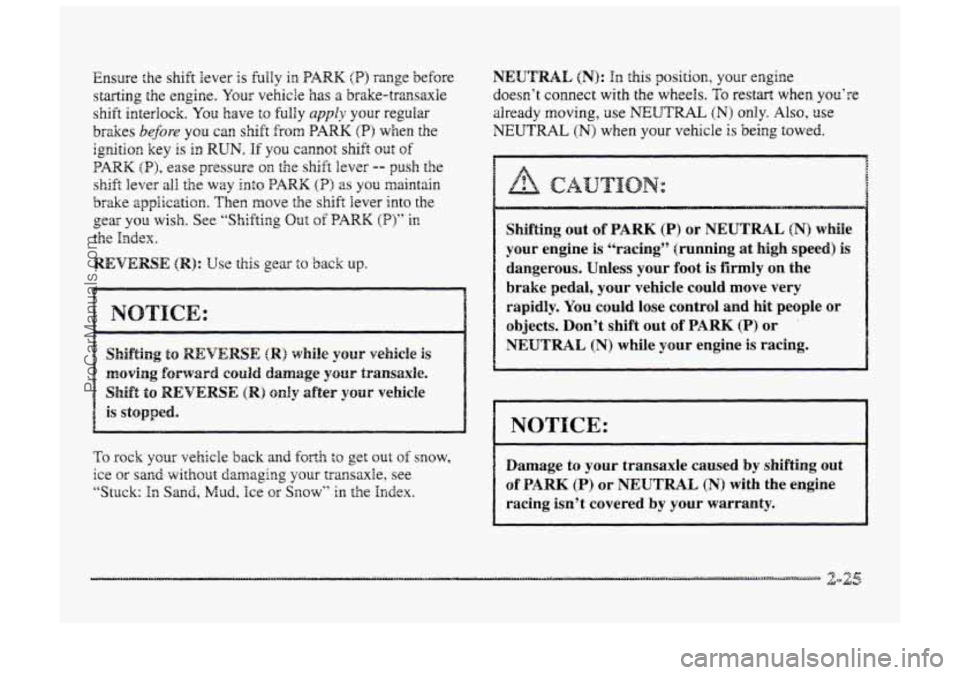
Ensure the shift lever is fuily in PARK (PI range before
starting the engine.
Your vehicle has a brake-transaxle
shift interlock.
You have to fully apply your regular
brzkes
before you can shift from PARK (P) when the
ignition key is in RUN. If you cannot shift out of
PARK (B), ease pressure on the shift lever -- push the
shift lever all the way into PARK (P) as you rnaintain
brake appiic~tion. Then move the shift lever into the
gear you wish. See “Shifting Out of PARK (E’)” in
the Index.
REVERSE (R): Use this gear to back up.
Shift to REVERSE (R) oanhy after vehicle
To rock your vehicle back and forth to get out of snow,
ice sand without damaging your transaxle, see
“Stuck:
In Sand, Mud, Ice or Snow” in the Index.
NEUTRAL (N): In this position, your engim
doesn’t connect with the wheels.
To restart when you’re
already
moving, use NEUTRAL (N) only. Also, use
NEUTRAL (N) when your vehicle is being towed.
Shifting out of PARK (P) or NEUTRAL fN) while
your engine is “racing” (running
at high speed) is
dangerous. Unless your foot is firmly on the
brake pedal, your vehicle could move very
rapidly. You could lose control and hit people
or
objects. Don’t shift out of PARK (P) or
NEUTRAL (N) while your engine is racing.
1 NOTICE:
Damage to your transaxle caused by shifting out
of PARK (P) or NEUTRAL (N) with the engine
racing isn’t covered by your warranty.
ProCarManuals.com
Page 93 of 426
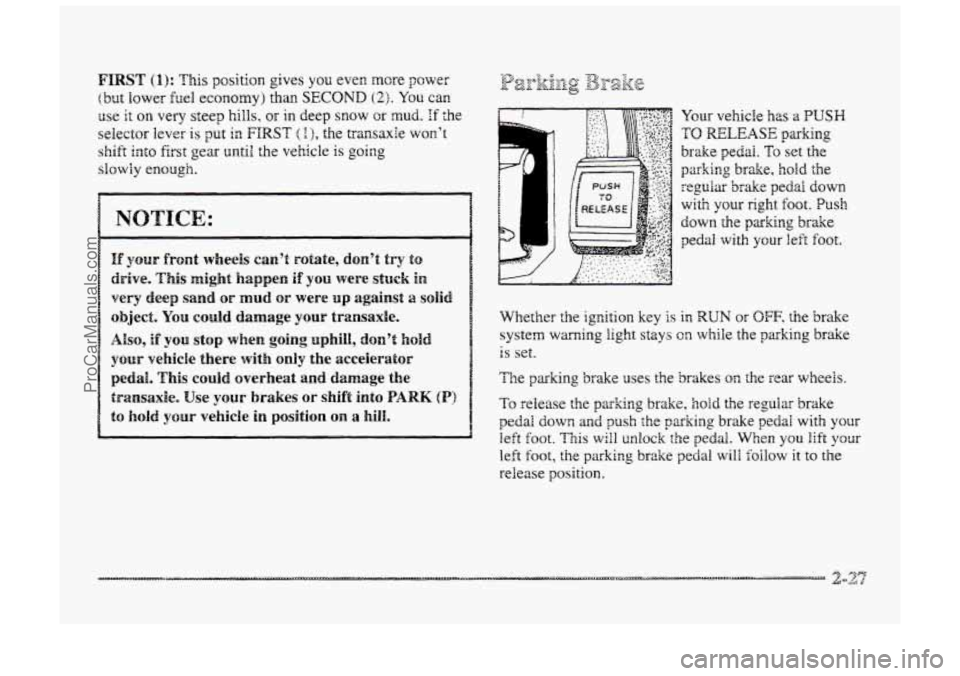
FIRST (I): This position gives you even more power
(but lower fuel economy) than SECOND (2). You can
use it on very steep hills, or in deep snow or mud. If the
selector lever is put in FIRST ( I >, the transaxle won’t
shift into first gear until the vehicle is going
slowHy enough.
If your hplrt wheels can’t rotate, don’t try to
drive. This might happen if YOU were stuck in
very deep sand OF mud or were up against a solid
object. You could damage your transaxle.
Also, if you stop when going uphill, don’t hold
your vehicIe there with only the accelerator
pedal. This could overheat and damage the
transaxle. Use ysur brakes or shift into BARK (P)
Your vehicle has a PUSH
TO RELEASE parking
brake pedai. To set the
parking brake, hold the
regular brake pedal down
with your right foot. Push
down the papking brake
pedal with your left foot.
~~ ~~
Whether the ignition key is in RUN or OFF. the brake
system
wming light stays on while the parking brake
1s set.
The parhng brake uses the brakes the rear wheels.
To release the parking brake, hoki the regular brake
pedal down and push the parking brake pedal with your
left foot. This will unlock the pedal. When you lift your
left foot, the parking brzke pedal will foilow it to the
release position.
ProCarManuals.com